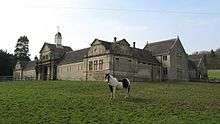Chesters (Humshaugh)
Chesters is an 18th century country mansion situated adjacent to Hadrian's Wall and the Roman fort of Cilurnum at Humshaugh, Northumberland, England. It is a Grade II* listed building.[1]

The house was built for John Errington of Walwick Grange[2] in about 1771 with three storeys and four bays but was much improved and extended by architect Norman Shaw in 1891. The 1891 work included five two-storeyed three-bay wings and a stable block. The stable block is separately Grade II* listed.[3]
Of the five wings, three were diagonal, creating suntrap flanks for the south and west fronts.[1] Shaw's remodelling of Chesters kindled the popularity of the Butterfly plan in the late 19th and early 20th centuries.[4]
The estate was acquired by Nathaniel Clayton[2] (Town Clerk of Newcastle upon Tyne 1785–1822) in 1796. His son John Clayton who succeeded him as Town Clerk in 1822 was a keen antiquarian and excavated the ruins of the Roman fort of Cilurnam adjacent to the house. He made a large collection of Roman artefacts, which is now displayed at Chesters Museum.
References
- 1 2 Historic England. "Chesters (1155585)". National Heritage List for England. Retrieved 24 October 2015.
- 1 2 The Beauties of England and Wales; Delineations Topographical, Historical and Descriptive Vol XII Pt I Rev J Hodgson and FC Laird (1813) p135 Google Books
- ↑ Historic England. "Stable Block 200 Metres North of Chesters (1370562)". National Heritage List for England. Retrieved 24 October 2015.
- ↑ Beckett, Matthew (24 October 2012). "The Butterfly House". New architecture blog. Country Life. Retrieved 24 October 2015.
External links
Coordinates: 55°01′37″N 2°08′42″W / 55.027°N 2.145°W